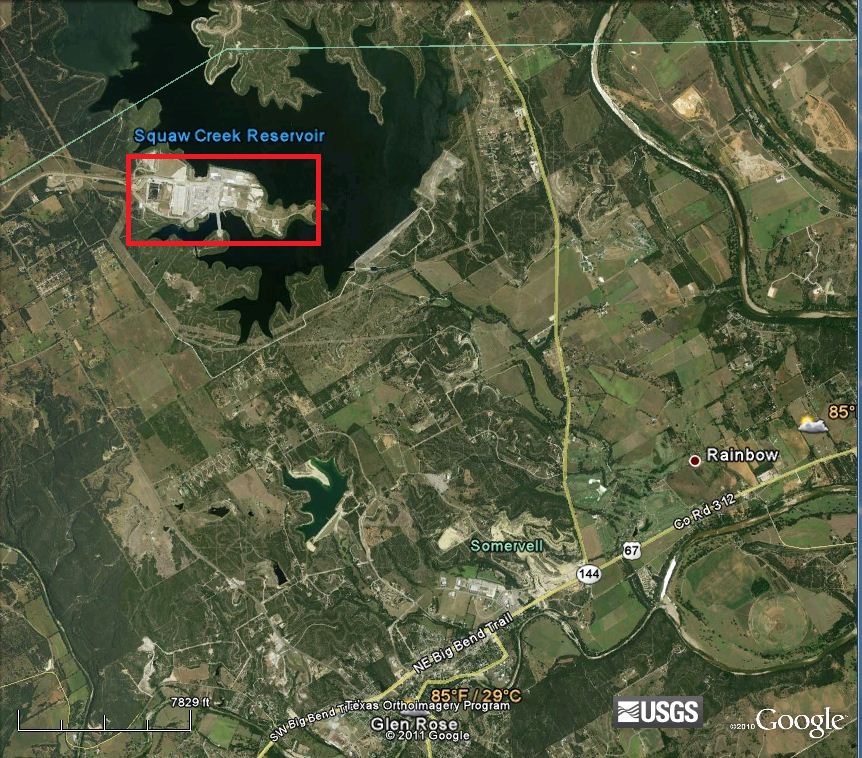
The Army Corps of Engineers wrote a letter in February recommending a 3000 foot setback from dams to prevent a “catastrophic event.” Mysteriously, the Corps later issued another letter that was less alarming but still emphasized the unknowns and possible danger of fracking near dams.
Hat tip to my friend, David, who got out of the Gas Patch but who still keeps watch over us. He found fracking near the Squaw Creek Comanche Peak Nuclear Plant and right under the Squaw Creek dam.
Some questions for you to ponder while you view the following maps?
- If fracking near a dam might cause a “catastrophic event,” what might fracking near a nuclear plant and under a dam cause? Is there anything worse than a catastrophe?
- What happens if fracking causes an earthquake near the nuclear plant like the 4.4 earthquake Snyder recently experienced? Earthquakes seem to follow fracking around.
- If fracking causes the dam to break, where will they get the water to cool the reactors?
- Does anyone remember a recent event where an earthquake caused problems at a nuclear plant?
From the Texas Railroad Commission GIS map we can see there are some Barnett Shale gas wells near the Squaw Creek Comanche Peak Nuclear Plant. The gray circle is 1/2 mile radius. Texas Railroad Commission records–which are rarely current because issuing drilling permits quickly is more important than keeping records current–indicate that 2H is the only well that is currently producing. Maybe 1H and 3H haven’t yet been fracked. Maybe Quicksilver should hold off on fracking the two remaining wells.
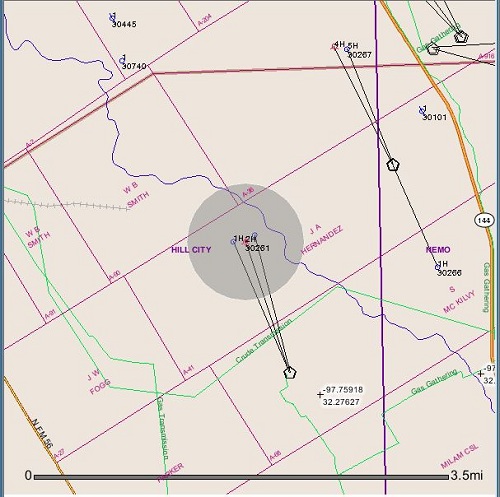
Barnett Shale gas wells near Squaw Creek Comanche Peak Nuclear Plant. Luminant Lease operated by Quicksilver Resources, Inc.
David mapped it out for us below showing distances. The pins show the location of the 3 Quicksilver wells. To see a larger version of this map, click HERE.
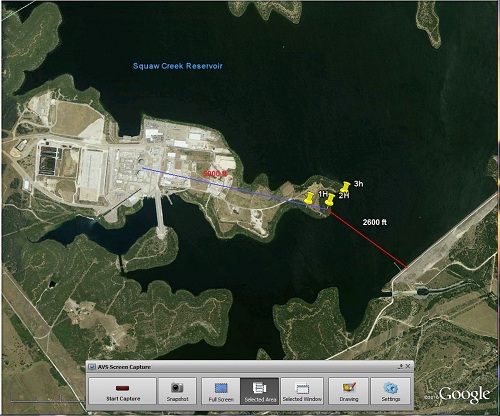
Barnett Shale gas wells under the Squaw Creek Comanche Peak Nuclear Plant and under the Squaw Creek Dam.
It’s hard to tell from what direction the Quicksilver wellbores might run and just how close they are to the dam. So I zoomed in on the TRC GIS map and located the roads that run near the Quicksilver pad site. Then I matched up the location on a Google map below. Note the green line that shows a pipeline is already in place.
You can zoom in and out on the below map to see how close the wells bores are to the dam.
View Fracking a nuclear plant in a larger map
Enjoy your Sunday. \
UPDATE: Some additional maps and a comment from David:
I located the well head on the surface and plotted the well bores. Funny thing Squaw Creek is not on the RRC maps? Security? The bores are 500ft apart. I checked the license for the plant, it last until 2033.Even if no earthquake or dam failure lets hope the fissiors don’t some day drop the water level below the plants intake!
And a comment from me: The FBI and Department of Homeland Security have been perusing my blog lately. Hey fellas, if you need something to do, here ya go!
To see a larger version of this map, click HERE.
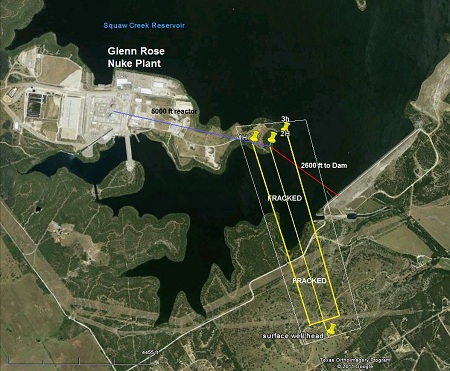
UPDATE 2: Quake shifted nuclear storage containers at Virginia plant
About Sharon Wilson
Sharon Wilson is considered a leading citizen expert on the impacts of shale oil and gas extraction. She is the go-to person whether it’s top EPA officials from D.C., national and international news networks, or residents facing the shock of eminent domain and the devastating environmental effects of natural gas development in their backyards.
- Web |
- More Posts(5121)
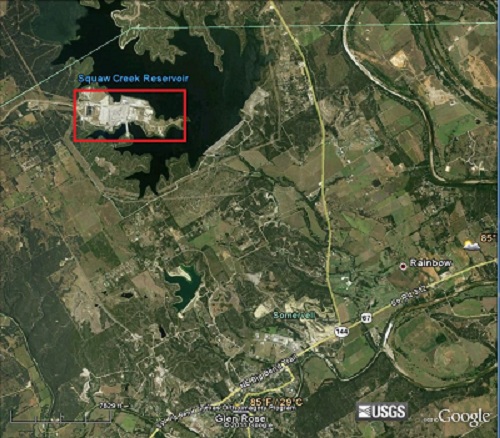
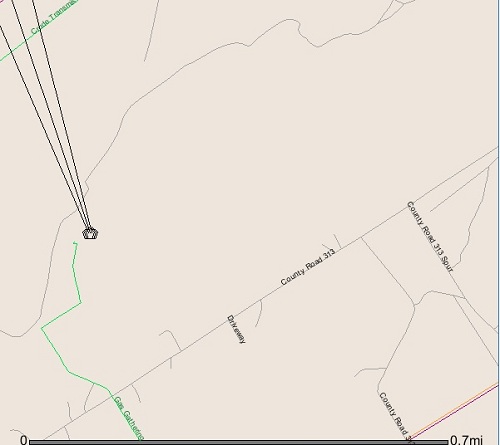

Do these companies not have to live on this earth? What could cause such tremendous greed…or is it just stupidity? Or are they aliens come to destroy us?
They are psychopaths. Don’t try to figure them out, just defeat them.
The nuclear power plant on Squaw Creek Reservoir is Comanche Peak. http://en.wikipedia.org/wiki/Comanche_Peak_Nuclear_Power_Plant
They are trying to build 2 additional reactors there. This is another of the many reasons they shouldn’t be allowed to do so.
Oh heck! Comanche Peak! I knew that.
I’m posting this history ,least we forget!
Comanche Peak Nuclear Power Plant in Glen Rose, Texas Background
From salon
http://salon.glenrose.net/default.asp?view=plink&id=1726
13:01 on 2 September 2006
I vaguely remember reading about Comanche Peak costs when I lived in Dallas before, but heck, that was way off in Somervell County. NOW I live here and I want to use this section to recap a few things that I didn\’t know before about the nuclear power plant. I have this feeling that there\’s a huge lobbying effort to make nuclear power look very good and I\’d like to examine if it\’s realistic.
From TexasRadiation.org
Repeated violations and cost overruns have plagued TXU at both sites, and both plants have been sited for problems during and after construction. Although construction of Comanche Peak took 20 years, the construction was rushed, and the NRC repeatedly fined TXU for falsifying blueprints and specs to pass inspections in a rush to get reactor online. This is but one example, as thousands of NRC violations have occurred at Comanche Peak, and cost overruns reaching tens of billions of dollars- a burden forced upon the ratepayers. It has been concluded that Comanche Peak was constructed with an ever-changing blueprint, and that these billions have been spent specifically to make the plant comply with federal safety requirements.
In 1986, NRC inspectors had found many problems in auditing the plant. The reactor vessel was found to not be installed according to engineering specifications. In addition, almost zero documentation was kept on the installation for quality control purposes, and it was found that the utility failed to identify these problems during the 14 years of construction. During this time, the utility was required to regulate the construction by conducting quality assurance audits, which they failed to do. In addition, inadequate control over critical records were identified, with thousands of document packages shipped offsite without oversight. Along with these problems, 30 other violations were reported in draft inspection reports and later removed under suspicious circumstances. The NRC\’s Office of Inspector and Auditor (OIA) stated that “(NRC) Region IV management harrassed and intimidated inspectors to pressure them to downgrade or delete proposed inspection findings” presumably in order to ensure that the plant went online sooner. [for more, see the section “Corruption at NRC Region IV”]
When construction began in 1974, TXU stated that the plant would be online to the Dallas-Fort Worth Area in 1980 at a cost of $779 million. It was almost $11 billion and 16 years later on April 3, 1990, that the first reactor came online. TXU has been forced to redesign Comanche Peak during and after its construction, reportedly adding more safety-related modifications than any other nuclear power plant in the country. This, in turn, has led to skyrocketing cost-overruns and a campaign of harassment meant to silence whistleblowers and expedite the building process when changes appeared too costly or time consuming. In it\’s first seven months, the plant had to be shut down on four separate occasions for repair work.
By 1992, Comanche Peak was still not fully completed, and was already faced with:
•- $10 Billion in cost overruns “one-third the taxpayers are to absorb”
•
– charges of collusion between NRC and Texas Utilities;
•
– documented cash settlements paid by Texas Utilities to former employees, apparently to silence whistleblowers and public interest groups The NRC originally condoned these settlements, then reversed it\’s position after a Senate subcommittee rebuked the agency in 1989;*
•
– workers repeatedly exposed to toxins, radiation and intimidation in the workplace;
•
– a list of thousands of non-conforming violations cited as well as hundreds of thousands of dollars in fines levied by the NRC.
Continuing concerns have been raised over:
•
– quality control at the plant;
•
– electrical wiring, specifically wiring with separation problems, which causes cables to short out or melt;
•
– the viability of the reactor shield;
•
– the fire safety problems;
•
– pipe supports meant to hold up the thousands of feet of piping responsible for conveying both radioactive water and coolant to and from the core (an accident, in this case, might lead most quickly to meltdown)
•
– the chronic falsification of documents to pass NRC inspections
Comanche Peak News: Comanche Peak\’s Unit 1 reactor was acting up alot in late 2002- early 2003, just as South Texas\’ reactor was having trouble. Starting on Sept. 28 2002, it was shut down when water was found leaking at a rate of about half a cup a minute from a tube carrying radioactive water to the steam generators. A subsequent check found corrosion in 667 other tubes in Unit 1, which had not yet started to leak. Each of the two reactors utilize more than 18,000 tubes which circulate radioactive, reactor-heated water from the reactor vessel to steam generators that make steam to turn power plant turbines.
A report from a NRC special inspection team found that three incidents of human error led to the steam generator tube leak, which should have been noticed and repaired as early as April 2001, when tests during a routine shutdown showed problems with the tube. In two of the mistakes were excused by the NRC. In the third incident, a plant employee reviewing computer data failed to report a marginal problem that later led to the leak.
A report by Nuclear Regulatory Commission inspectors said radiation monitors inside the plant\’s Unit 1 sounded alarms after recording high radiation readings on Sept. 26. Radiation levels peaked six more times before operators shut down the reactor two days later. The reactor was scheduled for a refueling shutdown and equipment inspection starting the following week.
Despite attempts to get the reactor running again, it was shut down 3 times in less than a month for other unrelated problems. Unit 1 resumed operation Nov. 15 but was then shut down Nov. 23 because of a potential valve problem. The reactor was back in service two days later. But on Nov. 30, the reactor shut down again when a blown fuse triggered a safety mechanism that caused a control rod to drop into the reactor\’s core. On Dec. 3, the reactor was taken off-line yet again, this time to repair an electric coil. Plant workers found that the coil failure was caused by a leaky weld in a canopy seal at the control rod mechanism. A document at the NRC website reports that 2 lbs (1 kg) of boric acid crystals were found evaporated all over the control rod mechanism and reactor vessel head!
Dallas Morning News reported that James Kelley, TXU vice president, said an economic analysis (not safety concerns) would show whether TXU should keep repairing damaged tubes or replace all four of Unit 1\’s steam generators, which would cost a total of $150 million. The plant is unlikely to be fined or otherwise penalized, said Dwight Chamberlain, director of the division of reactor safety at the NRC\’s Arlington office. Despite this huge deposit of boron evaporate of two pounds, the media and the NRC sensationalized South Texas Nuclear Project\’s tiny leak of a few grams, and ignored the Comanche Peak incident. The incident at South Texas has been given a full investigation with documentation, while the Comanche Peak incidents are only mentioned in a few NRC documents. Comanche Peak operators remain unpenalized, and the shutdown was listed as merely a “refueling outage” (refering only to the original shutdown, and not numerous mishaps during the attempt to restart.
Nuclear power plants have become a topic of renewed public criticism since September 11th, and much of what people had been saying for years about accidents and physical vulnerabilities of the plants resurfaced when comments were made by Al Qaeda that nuclear power plants were intended targets for attack. In addition, Texas is widely perceived as “Bush Country” which gives the state a special symbolic significance. Analysts have stated that in order to achieve maximum effect, an attack would be made on the spent fuel ponds, which would create more devastating effects.
The first piece of evidence to look at is a 1982 study by the NRC, Calculation of Reactor Accident Consequences, also known as CRAC-2, which was conducted at Sandia Labs, and published by US Congress. The data used was for a class-9, or worse case scenario meltdown of an merely an individual reactor at the plant, and are based on 1982 population data and dollars. The study revealed devastating risks of a meltdown of merely a single reactor at both Texas plants: tens of thousands of injured, over 5,000 deaths and hundreds of billions of dollars in damages, but this study only considered a thirty-mile radius, and did not incorporate meteorological precipitation or fallout. It also did not account for onsite spent fuel, which authors of the Reactor Safety Study stated would increase the number of these early fatalities by a factor of 3 to 4. The most recent estimate for an attack upon on-site spent fuel at US plants has concluded that burning spent fuel would spread contamination across an area anywhere from 8 to 70 times larger than the 1986 meltdown of Chernobyl. Economic and fatality estimates are limited under CRAC-2, partially due to the limited 30-mile radius considered under the study. Transportation bottlenecks during evacuation were not considered, nor were health care and other costs. Long term effects of radiation exposure were also not calculated, nor was fallout from the accident, within or outside of the 30-mile study area. In the chart below is the data for Texas power plants from the CRAC-2 study, with other basic information.
Price Anderson, the federal reactor insurance subsidy, only provides $8 billion in coverage for a given accident. The costs of Chernobyl have been estimated above $350 billion, and the Texas reactors were estimated in the CRAC-2 study to require between $112-117 billion each. The taxpayer\’s liability under Price Anderson is significant, and shows $8 billion to be a small contribution. Plus, due to the existence of Price Anderson, insurance providers refuse to cover damages sustained in the event of a nuclear accident.
Some proponents claim that nuclear power reduces air emissions, and ignore all pollution produced in fuel production. Uranium mining, fuel enrichment and plant construction contribute significant amounts of air pollution, in the form of CO2 and CFCs. Mining is one of the most CO2 intensive industrial operations and as demand for uranium grows CO2 emissions are expected to rise as core grades decline. Depending on the reactor and fuel grade, from 34-60 grams of CO2 are emitted per generated kilowatt hour. In total, a nuclear power station of standard size (1,250MW operating at 6,500 hours per year) indirectly emits between 376,000 million and 1,300,000 million tons of CO2 per year. During the uranium enrichment process, large amounts of freon are utilized to cool equipment and uranium hexafluoride in the plants, and much escapes to the atmosphere through leaks in piping. This freon was purchased and inventoried prior to a ban on the import and production of CFCs by the Montreal Protocol and Clean Air Act amendments of 1990, which allowed industry to use existing supplies. The two enrichment plants in Portsmouth, Ohio, and Paducah, Kentucky, released 818,000 pounds of freon in 1999 alone. The enrichment process accounts for a huge 88% of US industrial CFC emissions, and an estimated 14% of all CFC-114 emissions worldwide. Pollution from nuclear power plants in discussed at some length in the other section, Not Clean: Nuclear Power Pollution.
“It is not too much to expect that our children will enjoy in their homes electrical energy too cheap to meter,” Atomic Energy Agency, Chairman Lewis Strauss, 1954.
As they operate, hundreds of millions of dollars each year are sucked out of our city budgets each year to pay for utility partnerships with nuclear power plant operators. These utilities are burdened with billions in plant cost overruns, which is passed onto the ratepayer. When the City of Austin joined STNP in 1973, plant was said to cost $1 billion, with the city\’s share at $161 million. This cost has ballooned to $6.2 billion with the city\’s share reaching over $1 billion. Austin Energy, a 16% partner in South Texas Project, budgeted $128 million a year to the plant by 1995, amounting to 40% of the ratepayer\’s bill- and these numbers have also become inflated over the years. Nuclear power has proved to neither be cheap, nor clean, and should be replaced with wind power which brings in very inexpensive megawatts to west Texas. This has been proven to generate State income rather than allow plant operators to suck it away. The power distribution grid also needs to be extended to these west Texas wind farms, to bring this renewable energy source to cities such as Houston, Dallas-Ft Worth, Austin and others. Decommissioning these nuclear plants will remove the financial and security liability in addition to solving the problem of long-lived nuclear waste.
Chet Edwards voted for the 2005 Energy Bill, which included a cap on payments of liability for nuclear power plant accidents. Here\’s the elements that deal specifically with nuclear power plant energy.
Online Search is Down.
[…]
Website Maintenance — webapps.rrc.state.tx.us
This website is undergoing maintenance and is currently unavailable. Please try again later.
[…]
http://www.rrc.state.tx.us/maintenance/webappsmaintenance.html
You won’t be able to check it right now….but check out the GIS mapping of the shale gas wells to the west of the nuclear plant and the dam (as of yesterday).
http://westchestergasette.blogspot.com/2011/09/dam-and-double-dam.html
Luminant = TXU = Rick Perry. What grade did he make in Nuclear Science?
Doubling the size of Comanche Peak. Do you Think Perry and his crew will be able to slam dunk this like the radiation dump in “far west Texas”?
Application Review Schedule for the Combined License Application for Comanche Peak Nuclear Power Plant, Units 3 and 4 : http://www.nrc.gov/reactors/new-reactors/col/comanche-peak/review-schedule.html
I expect it to be a slam dunk. People have shopping to do so there is no time to sorry about such things as a future for the planet.
An electrician that worked on the Bay City nuclear plant during its construction days once told me that he and his crew were required to rewire one room nine different times. What was the problem: poor initial design? changes in design eight times? incompetent work? Need to spend money to keep the amount justified in the budget? Need for job security for upper level managers for extended periods of time, lest the job be finished on time, on schedule and within the budget?? (The fact is that nuclear plants are always financed by federal loans, since no private banks will take the risk of such enormous amounts of money tied to a loan that the record shows always involves cost overruns as the project unfolds. Seems like a real political/industrial racket to me that makes outgoing President Dwight D. Eisenhower’s warnings about the “military-industrial complex” look like a “yield” sign.) Whatever the cause, waste of public funding is the bottom line in terms of business and federal spending accountability. Then there is the far more important issue of the public health if incompetence in management and worker performance went into this plant in other critical places.
But one thing is different now: more aware citizens who can talk to each other and get the truth out. Thanks to all who are helping to do this for our national security. There is no higher form of patriotism than this. There is no lower form of betrayal of one’s country than selling out public health, public safety and public funds to irreponsible corporate greed. Terrorists would not be allowed to do what they do. It is the deed, not the name or the cause, that lies at the heart of terrorism and treason. How many times in the history of “war” has “the enemy” come dressed in the garb of one’s own defenders? Wolves in sheeps clothing was one of Jesus’ warnings to those who love Truth and Justice.
Cancel your accounts with Atmos and TXU. They use fracking companies like Chesapeake. They make up most of the gas lines around here. Atmos does. If every business and residence did this would solve the problem. Boycott stores that use fracked gas until they stop. Just make sure they really stopped. This is craziness that has gotten out of hand and we have control in the form of consumerism.
TXU uses Atmos and Atmos uses Chesapeake. Channel eight advertises TXU. Boycott channel 8. Do whatever it takes.
Oh and channel 21, which is channel 11’s sister station, had a chesapeake sponsored parade. D-I-S-G-U-S-T-I-N-G. I bet none of those attendees know who chesapeake is or care. I bet they are all wondering what the smell is and why they are sick tho.
bogus media. Sorry for blabbing.
the cute FBI agents should just announce themselves, they stick out like sore thumbs, and i’m single